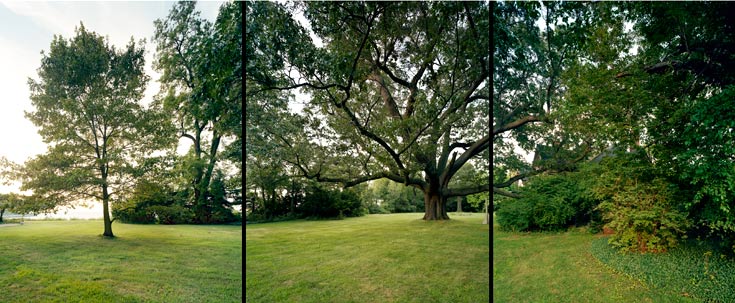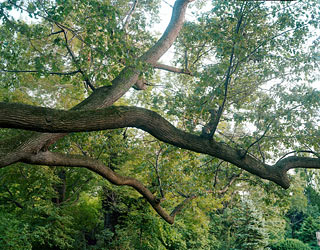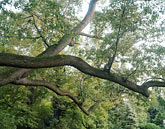

Photographs © Barbara Bosworth
Katewood, historically owned by the Holden family known for their horticultural interests and as the founders of the Holden Arboretum, is a Country Place era estate designed by A.D. Taylor. The black oak tree (Quercus velutina) located on the property pre-dates the house and has a diameter of more than eight feet at breast height. After a tornado hit the area in 1992, several of the tree’s support cables had to be replaced and a crutch was installed to support one of the largest branches. Today, though the tree relies on supports, it stands as a remnant of the area’s pre-settlement period.
History
The black oak tree in July 2007
During the late 19th century, Cleveland’s wealthy families flocked to the shores of Lake Erie to escape the summer heat. First staying in elaborate tents, then building even more elaborate mansions on grand estates, these new residents spurred development of tree lined-streets and small commercial centers in areas previously characterized by rural farms. Reflecting such development, in 1903, residents Liberty E. Holden, Samuel Mather, and Frederick Goff moved to establish Bratenahl, located just six miles north of Cleveland, as an independent village.
Holden, a former public school teacher, had become interested in real estate ventures, including mining endeavors, and by the 1870s had settled in the Cleveland area, purchasing the Cleveland Plain Dealer and constructing the Hollenden Hotel. In 1898, he began construction of his estate, Katewood, which included the already grand black oak tree (Quercus velutina). During the 1920s, the Holden family requested that landscape architect A.D. Taylor add a greenhouse and carriage house and expand the gardens and site plan. Taylor called out the black oak in his plans for the estate and, in 1930, he measured its span at 110 feet.
Throughout the decades that Taylor worked on the property, the Holden family's expanded civic as well as horticultural interests led them to found the Holden Arboretum in Kirtland, Ohio, in 1931. The very first planning sessions for the arboretum, modeled after Harvard University’s Arnold Arboretum, took place at Katewood.
In the years following establishment of the Holden Arboretum, the family continued to engage professional arborists to care for the Katewood’s trees, including the black oak. By the 1970s, The Davey Tree Expert Company assigned a full crew of arborists to the five-acre estate. The company was charged with maintaining the trees in both the formal gardens and the wooded areas, which required their presence nearly 40 weeks a year. The black oak, by far the largest tree on the estate, was pruned and fertilized to assure even growth. The crew worked the property until the mid-1970s, when family members downsized management of the estate.
In 1992, a severe summer storm and subsequent flooding produced significant damage at Katewood. Branches and supporting cables were torn from the black oak. The estate’s owners engineered a plan to install new cabling and a crutch that would provide support for the tree’s largest branch. Today, the tree has a diameter of approximately 100 inches at breast height. The property owners continue to care for the tree by avoiding disturbing the soil beneath the canopy and keeping the water the tree receives at consistent levels.

Photograph © Barbara Bosworth
Threat
The greatest threat to the tree is now age and a lack of funds for the required maintenance. Likely more than 250 years old, the tree has survived storms and surrounding development in this constantly changing region. Although relatively little dieback has been observed in recent years, the tree relies on cable bracing to relieve the stress caused by heavy branches.


